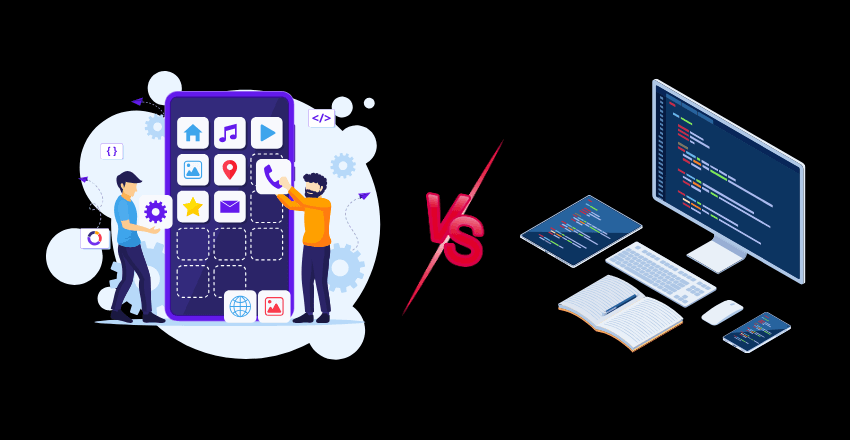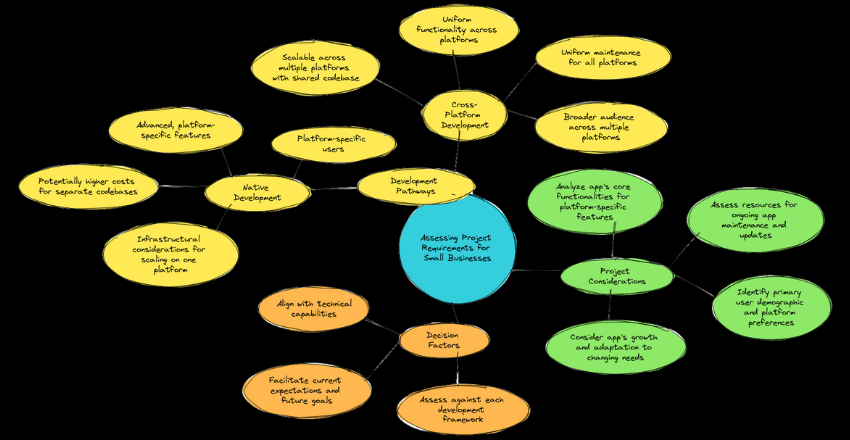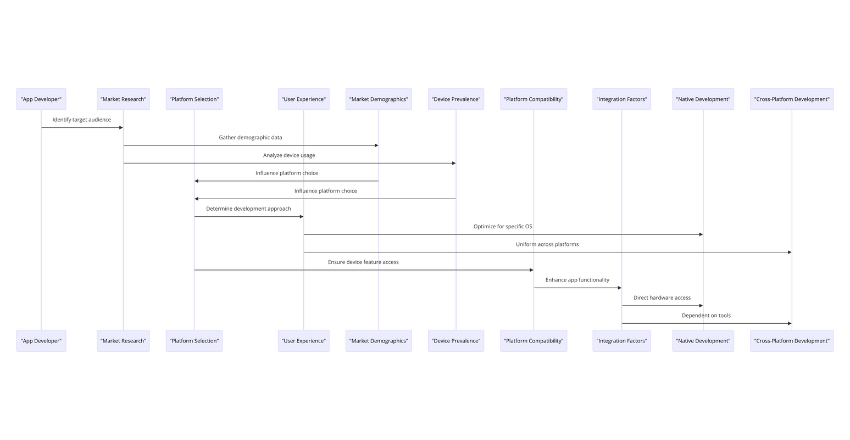

Native and Cross-Platform Development
As mobile technology evolves, so does the process of building applications that deliver seamless, intuitive experiences. Understanding the distinctions between native and cross-platform development is key for developers and businesses aiming to create impactful mobile apps.
What is Native App Development?
Native app development involves creating applications for particular mobile operating systems using the programming languages and tools specifically designed for those platforms.
Major players like Apple’s iOS and Google’s Android each have their own set of development tools, SDKs, and languages – Swift or Objective-C for iOS and Kotlin or Java for Android. The advantages of native development hinge on unmatched performance, superior user experience, and full access to device capabilities and hardware.
What is Cross-Platform App Development?
Contrasting with native development, cross-platform app development enables programmers to write a single codebase that can run on multiple operating systems. This methodology leverages universal languages like JavaScript, alongside frameworks such as React Native or Flutter, to construct applications that deliver a consistent user experience across diverse devices.
Cross-platform app development comparison often centers around its cost-effectiveness and quicker time-to-market.
Key Differences Between Native and Cross-Platform Environments
The debate of native vs hybrid app development continuously evolves, with developers weighing various factors such as:
- Platform Compatibility: Native apps typically offer optimized performance for their specific platform, while cross-platform applications provide broader accessibility at the potential expense of performance.
- Mobile Frameworks: Native development requires a deep understanding of platform-specific frameworks, whereas cross-platform apps utilize universal frameworks that abstract away the platform details.
- Development Time and Resources: Native apps are developed independently for each platform, which can increase time and resources, whereas cross-platform development allows sharing of code across platforms.
To further clarify, let’s consider a native vs hybrid app development table that details the specific attributes of each approach:
| Criteria | Native Development | Cross-Platform Development |
|---|---|---|
| Language/Framework | Swift, Objective-C, Kotlin, Java | JavaScript, React Native, Xamarin, Flutter |
| Performance | High (direct hardware access) | Varies (dependent on bridging technologies) |
| User Experience | Fluid and intuitive | Consistent across platforms, may lack platform-specific enhancements |
| Development Cost | Higher (separate codebases) | Lower (shared codebase) |
| Maintenance | Platform-specific | Unified, but potentially more complex updates |
This comparison presents a snapshot of the core differences, but the ultimate choice hinges on the project’s specific requirements and anticipated growth. As the mobile landscape becomes increasingly diverse, understanding these developmental nuances is essential for delivering effective mobile applications.
Assessing Project Requirements for Small Businesses

When embarking on the development of a mobile application, small businesses face a crucial decision-making process that hinges on their unique project requirements. It’s essential to consider the diverse mobile app development options available when choosing between native and cross-platform development methodologies.
This decision will significantly impact the app’s future performance, viability, and sustainability, thereby echoing the importance of aligning business objectives with technical capabilities.
To aid in this decision-making process, the following table distills key project considerations that small businesses must weigh. These factors will help determine the most suitable path—whether to invest in native app development tailored to specific platforms or opt for a cross-platform approach that targets a broader audience with a single codebase.
| Consideration | Native Development | Cross-Platform Development |
|---|---|---|
| Target Audience | Platform-specific users | Broader audience across multiple platforms |
| Desired Functionality | Advanced, platform-specific features | Uniform functionality across platforms |
| Scalability | Infrastructural considerations for scaling on one platform | Scalable across multiple platforms with shared codebase |
| Maintenance Expectations | Potentially higher costs for separate codebases | Unified maintenance for all platforms |
Considering the above table, small project app development is not a one-size-fits-all situation. Whether a business leans towards native or cross-platform development should be grounded in a practical assessment of these key project elements.
Small businesses must factor in the nuances of their app’s project requirements to ensure the chosen development pathway facilitates not only current expectations but also future ambitions.
- Identify the primary user demographic and their platform preferences
- Analyze the app’s core functionalities and the need for platform-specific features
- Consider the app’s growth trajectory and how fast it needs to adapt to changing user needs
- Assess the resources available for ongoing app maintenance and updates
Ultimately, whether prioritizing the high-performance potential of native applications or the versatile distribution of cross-platform solutions, small businesses must carefully map their project requirements against the technical benefits and constraints of each development framework.
This analytic approach will guide entrepreneurs through the intricacies of mobile app development options, empowering them to make informed choices strategically aligned with their business’s goals.
Comparing Development Costs: Budgeting for Your Project

When embarking on a mobile app project, understanding the various financial considerations is key to budgeting effectively. Small businesses, in particular, need to weigh the development cost implications of different development strategies.
The choice between native and cross-platform development can significantly impact both initial investments and long-term expenses.
Native Development Expenses
Opting for native development typically means incurring higher upfront costs due to the need for specialized skill sets in languages and tools specific to each platform, like Swift for iOS or Kotlin for Android. The investment extends to the development tools and licenses required for each platform.
However, this approach brings distinct advantages in performance and full access to device features, which can be crucial depending on the app’s requirements.
Cross-Platform Development Savings
Cross-platform development frameworks such as React Native or Flutter allow businesses to write one codebase to deploy on multiple platforms, which can lead to considerable savings in both time and money. Maintenance and updates are streamlined, as a single codebase requires less effort to manage than multiple native ones.
The pros and cons of cross-platform development warrant careful consideration, especially regarding how they align with project goals and user expectations.
Long-Term Cost Implications
While initial costs are a significant part of budgeting, the long-term financial implications of an app’s lifecycle cannot be overlooked. Maintenance costs, the need for frequent updates, and scalability are all factors that contribute to the total cost of ownership.
A technical comparison of the two approaches reveals that while native apps may require higher initial investment, they can potentially lead to lower costs over time with fewer compatibility issues and optimizations.
| Cost Factor | Native Development | Cross-Platform Development |
|---|---|---|
| Initial Development | Higher due to platform-specific development | Lower due to shared codebase |
| Maintenance | Can be higher due to multiple codebases | Lower due to unified codebase maintenance |
| Updates | More complex as updates must be platform-specific | Simpler with one update affecting all platforms |
| Long-term Scalability | More control for optimization but at a cost | Dependent on framework’s capabilities |
Carefully analyzing both the immediate and enduring financial demands of your chosen development path will ensure a more informed decision. This assessment must balance the development cost against the strategic importance of performance, user experience, and market reach for your mobile application.
Performance Analysis: Native vs Cross-Platform for Small Projects

When it comes to app performance, the debate between native and cross-platform development encompasses several critical factors. Performance analysis for small projects can be significantly impacted by the development path chosen.
With native app development, applications are crafted for specific platforms using their dedicated programming languages and environment. This typically results in improved speed and responsiveness, giving native apps the edge in performance. Conversely, cross-platform apps aim for practicality and broader reach by utilizing a shared codebase that works on multiple platforms.
However, this one-size-fits-all solution can sometimes hinder maximum performance optimization.
To illustrate the pros and cons of each in terms of performance, consider the following aspects:
- Speed: Native apps are often faster as they leverage the full capability of the underlying operating system and hardware.
- Responsiveness: Native development can better handle high-load tasks and graphics-intensive applications, providing a smoother user experience.
- Device Integration: Native apps can seamlessly integrate with device-specific features, such as cameras, microphones, or sensors.
- User Experience: With superior access to native APIs and UI controls, native apps can deliver an intuitive and interactive experience that feels right at home on the device.
| Criteria | Native App Performance | Cross-Platform App Performance |
|---|---|---|
| Speed | Optimized for maximum efficiency on target OS | Varies, may have some lag due to abstraction layers |
| Responsiveness | Highly responsive to user interaction | Responsive, with potential minor delays |
| Device Integration | Direct interaction with hardware and platform features | Limited by the capabilities of cross-platform frameworks |
| User Experience | Streamlined and platform-specific interface | Consistent across platforms, might not fully leverage native UI elements |
The choice between native and cross-platform app development for small projects hinges on balancing these attributes with resource constraints.
While native development can offer significant pros in app performance, it’s important to weigh these against the potential cons like increased costs and longer development times. Performance analysis should be conducted meticulously, to align the technical aspirations of the app with the realistic capabilities of the business.
Platform Selection: Matching Your App to the Right Audience

When embarking on the journey of app development, one of the pivotal decisions you’ll encounter is platform selection. This crucial choice carries significant weight, as it directly correlates to who will ultimately use your app and how. A thorough understanding of user experience, market demographics, and device prevalence becomes invaluable information that can steer your project towards success.
User Experience and Interface Consistency
First and foremost, the user experience is the cornerstone of any successful application. Users expect a seamless, intuitive, and engaging interface that delivers consistency across various devices and operating systems. This consistency can be particularly challenging to achieve in cross-platform development, yet it’s paramount for retaining users and encouraging the longevity of the app.
Market Demographics and Device Prevalence
Understanding your target market’s demographics is crucial in determining the platforms you should prioritize. Factors such as age, location, income level, and even hobbies can influence the prevalence of certain devices within your target audience.
This market insight helps to make data-driven decisions about whether a native or cross-platform approach will offer the most significant advantages in reaching your desired user base.
Platform Compatibility and Integration Factors
Lastly, platform compatibility and the capability for seamless integration with other apps and services should be factored into your platform selection strategy. An app’s ability to interact with a device’s native features and other commonly used applications can enhance the user experience and functionality, ultimately contributing to the app’s success in a crowded marketplace.
| Consideration | Native Development | Cross-Platform Development |
|---|---|---|
| User Experience | Highly optimized for specific OS | Uniform across different platforms |
| Market Demographics | Targeted platform choice based on audience | Broader reach across various segments |
| Device Prevalence | May prioritize high-end mobile devices | Covers a wide range of devices |
| Platform Compatibility | Direct access to device’s hardware and features | Integration dependent on cross-platform tools |
Wrapping up
The selection between native and cross-platform frameworks should not be taken lightly; it warrants a deep dive into all aspects of development, from technical comparison to market demographics. As we close this comprehensive analysis of small project app development, it’s crucial for business owners to assess their goals against their resource capabilities.
Armed with today’s insights, it’s our hope that the right decision is made—a decision that propels a business forward in the digital marketplace with a robust and user-centred mobile application.
External Resources
https://dotnet.microsoft.com/en-us/apps/xamarin
FAQ

FAQ 1: How does testing differ between native and cross-platform applications for small projects?
Answer:
Testing native applications often involves platform-specific tools and frameworks. For Android, you might use Espresso, and for iOS, XCTest. These tools allow for detailed testing of UI elements and platform-specific features. Cross-platform applications, developed with frameworks like Flutter or React Native, can be tested with tools like the Flutter testing framework or Jest for React Native, which provide a unified testing environment across platforms.
Code Sample Explanation (Flutter):
testWidgets('Counter increments smoke test', (WidgetTester tester) async {
// Build our app and trigger a frame.
await tester.pumpWidget(MyApp());
// Verify that our counter starts at 0.
expect(find.text('0'), findsOneWidget);
expect(find.text('1'), findsNothing);
// Tap the '+' icon and trigger a frame.
await tester.tap(find.byIcon(Icons.add));
await tester.pump();
// Verify that our counter has incremented.
expect(find.text('0'), findsNothing);
expect(find.text('1'), findsOneWidget);
});This Flutter test checks that tapping a button increases a counter in the app. It’s a simple example of how cross-platform frameworks provide their own tools for UI and functionality testing, facilitating testing across all platforms the app runs on.
FAQ 2: How does performance optimization vary in native vs cross-platform development for small projects?
Answer:
In native development, performance optimization is directly tied to the specific capabilities and limitations of the operating system. This allows developers to leverage platform-specific features and optimizations, such as multithreading on Android with Kotlin Coroutines or iOS’s Grand Central Dispatch (GCD).
Cross-platform frameworks, however, abstract these details away, offering their own methods for managing performance. While this simplifies development, it may require additional work to achieve native-like performance, especially for resource-intensive applications.
Code Sample Explanation (Kotlin Coroutines on Android):
GlobalScope.launch(Dispatchers.IO) {
// Background thread
val data = fetchData() // Assume this fetches data from a network
withContext(Dispatchers.Main) {
// Update UI
view.text = data
}
}This Kotlin example demonstrates using Coroutines for background processing in an Android app. It fetches data in a background thread and then updates the UI on the main thread, optimizing performance by keeping the UI responsive.
FAQ 3: How does code maintenance and updating differ between native and cross-platform solutions for small projects?
Answer:
Maintaining and updating native applications typically involves parallel development paths for each platform, requiring updates to be made separately for iOS and Android. This can lead to higher maintenance costs but allows for fine-grained control over the app on each platform.
Cross-platform frameworks allow for a single codebase to be used across multiple platforms, simplifying the update process. However, developers must be cautious of dependencies and the cross-platform framework’s lifecycle, as updates to the underlying platform could necessitate updates to the framework or dependencies.
Code Sample Explanation (React Native):
import { Platform, StyleSheet } from 'react-native';
const styles = StyleSheet.create({
container: {
...Platform.select({
ios: {
backgroundColor: 'blue',
},
android: {
backgroundColor: 'green',
},
}),
},
});This React Native example showcases conditional styling based on the platform, illustrating how cross-platform frameworks can still accommodate platform-specific customization within a unified codebase.
It simplifies maintenance by allowing most of the code to remain platform-agnostic, with only specific sections requiring platform-specific attention.
Charlotte Williams is a talented technical author specializing in cross-platform app development. With a diverse professional background, she has gained valuable experience at renowned companies such as Alibaba and Accenture. Charlotte’s journey in the tech industry began as a mobile UX designer back in 2007, allowing her to develop a keen understanding of user-centric app design.
Proficient in utilizing frameworks like React Native and Flutter, Charlotte excels in building cross-platform mobile apps and imparting her knowledge to aspiring developers. She pursued a degree in Computer Science at Cornell University, equipping her with a strong foundation in the field. Residing in San Francisco with her three beloved dogs, she finds solace in hiking the hills and connecting with nature. Charlotte’s passion for app development, combined with her dedication to sharing expertise, makes her an invaluable resource in the world of cross-platform app development.






